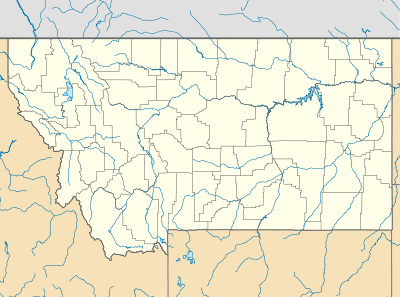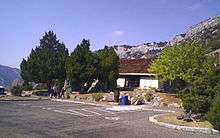Lewis and Clark Caverns
| Lewis and Clark Caverns State Park | |
|---|---|
|
Illuminated interior of Lewis and Clark Caverns | |
 | |
| Location | Jefferson County, Montana |
| Coordinates | 45°49′22″N 111°51′03″W / 45.82289°N 111.85082°WCoordinates: 45°49′22″N 111°51′03″W / 45.82289°N 111.85082°W[1] |
| Area | 3,015 acres (1,220 ha) |
| Operated by | Montana Fish, Wildlife and Parks |

Lewis and Clark Caverns State Park is located in southeastern Jefferson County, Montana. The primary feature of the park is its namesake limestone cavern.
The caverns have been familiar to Native Americans since long before their discovery by Europeans. The Lewis and Clark Expedition camped within sight of the caverns on July 31, 1805, when they camped along Antelope Creek. The cavern was first discovered by non-Native Americans in 1882 by two people from Whitehall, Montana, Charles Brooke and Mexican John. However, they told few people and at the time their discovery did not become well known. In 1892, local ranchers Tom Williams and Bert (or Burt) Pannel saw steam coming from the caverns while hunting. In 1898, Williams finally explored the caverns. Williams wanted to begin giving tours to the caverns but in 1900 a court battle over ownership ensued and the railroad won. In 1908, the railroad gave the land to the federal government.[2]
The cave was first developed for tours around 1900 by Dan A. Morrison, who called it Limespur Cave. The site was first officially established as "Lewis and Clark Cavern National Monument" on May 11, 1908, but was not fully surveyed and declared until May 16, 1911, by President Taft as 160 acres (0.65 km2). The limestone cave is named after the explorers Meriwether Lewis and William Clark since the cavern overlooks over 50 miles (80 km) of the trail from the Lewis and Clark Expedition along the Jefferson River,[3] although Lewis and Clark never saw the cavern. Lewis and Clark did however pass through portions of the modern day park. It is located approximately 45 miles (72 km) west of Bozeman, Montana, and 60 miles (97 km) northwest from the northwest corner of Yellowstone National Park. The caverns are also notable in that much of the work done to make the cave system accessible to tourists was performed by the New Deal-era Civilian Conservation Corps.[2]

It was disbanded as a national monument on August 24, 1937,[4] and transferred to the state of Montana. On April 22, 1938, Morrison Cave was declared Montana's first State Park.[5] The site was formally dedicated in May 1941.[3][4][5]
Geology
Lewis and Clark Caverns was dissolved by slightly acidic groundwater in tilted beds of the Madison Limestone of Mississippian age. This limestone was formed by layers of calcium rich organisms that died in a sea that was present around 325 and 365 million years ago.[2] Reddish sandstone, known as the Amsden, laid down in the Pennsylvanian age was uplifted to current heights during the Laramide Orogeny around 70 million years ago. This uplift constructed joints in the Madison Limestone that would later become caves, such as the Lewis and Clark Caverns.[6] Most of the cave was probably excavated during the ice ages, a time of much greater water supply than today.[7]
Western big-eared bats
There used to be thousands of western big-eared bats in the caverns but now there are only about 100 females, which nest inside the caverns.[2] The males are believed to live in other caves nearby. These bats eat thousands of bugs every day. Bats have opposable thumbs and are "the only mammals capable of true flight."[8] The year 2012 was declared the "Year of the Bat" at the caverns, with a special celebration from August 7–11. The guano of these bats was collected by the Civilian Conservation Corps during World War II and used to make TNT. There are also lots of springtails in the caves.[8][9]
Activities
The park is open every day of the year except Thanksgiving, Christmas, and New Year's Day.[1] The caverns, however, are only open from May 1 to September 30 and for holiday tours during December. Available activities and amenities include: amphitheater, bicycling, bird watching, camping, restrooms, camper dump station, fire rings, fishing, hiking, mountain biking, kennels, kiosk and information station, cabins, parking, photography, picnicking with tables, playgrounds, retail firewood, ice, trails, freshwater, and wildlife.[10][11] Guided tours of the caverns are available from May 1-September 30, are 2 miles (3.2 km) in distance, and last 2 hours.[10]
References
- 1 2 "Lewis and Clark Caverns State Park". Montana Fish, Wildlife, and Parks.
- 1 2 3 4 "Lewis and Clark Caverns". Montana Department of Tourism. Retrieved September 15, 2012.
- 1 2 "Lewis & Clark Caverns State Park". AllTrips: Bozeman Montana. Retrieved September 15, 2012.
- 1 2 "Come Explore Montana's Natural Places". Montana Fish, Wildlife & Parks. Retrieved September 15, 2012.
- 1 2 Smith, Jeffrey J (2003). The Montana book of days: the short course in Montana history. Missoula, Montana: Historic Montana Publishing. p. 115. ISBN 9780966335569.
- ↑ "Caving in Montana: Crystals Galore". Helena Heliotrope. February 23, 2011. Retrieved September 15, 2012.
- ↑ Alt, David D.; Hyndman, Donald W. (1988). Roadside Geology of Montana. Mountain Press Publishing Co. pp. 179–180. ISBN 978-0-87842-202-9.
- 1 2 Hausen, Jodi (June 3, 2012). "The batty world of Lewis and Clark Caverns State Park". Bozeman Daily Chronicle. Retrieved September 15, 2012.
- ↑ "Lewis and Clark Caverns State Park" (PDF). Montana Fish, Wildlife & Parks. Retrieved September 15, 2012.
- 1 2 "Lewis and Clark Caverns, MT". Reserve America. Retrieved September 15, 2012.
- ↑ "Lewis and Clark Caverns State Park". Visit Montana. Retrieved September 15, 2012.
External links
| Wikimedia Commons has media related to Lewis and Clark Caverns State Park. |
- Lewis and Clark Caverns State Park Montana Fish, Wildlife & Parks
